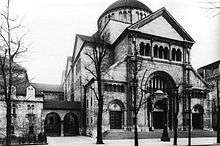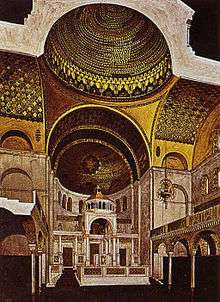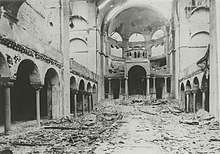Fasanenstrasse Synagogue
The Fasanenstrasse Synagogue was a liberal Jewish synagogue in Berlin, Germany opened on 26 August 1912. It was located in an affluent neighbourhood of Charlottenburg on Fasanenstrasse off Kurfürstendamm at numbers 79–80,[1] close to the Berlin Stadtbahn and Zoo Station.
| Fasanenstrasse Synagogue | |
|---|---|
 Fasanenstrasse Synagogue about 1916 | |
| Religion | |
| Affiliation | Reform Judaism |
| Leadership | Former rabbis included Leo Baeck |
| Status | Closed by the Nazis in 1936, burned during Kristallnacht in 1938, destroyed during Allied bombing in 1943 |
| Location | |
| Location | Fasanenstrasse, Charlottenburg, Berlin |
| Geographic coordinates | 52°30′16″N 13°19′41″E |
| Architecture | |
| Architect(s) | Ehrenfried Hessel |
| Style | Neo-Romanesque with Byzantine elements |
| Completed | 1912 |
| Capacity | 1,720 |
Construction

The fast-growing Jewish Community in Charlottenburg purchased the premises in 1905 and following an architecture competition the synagogue was built from 1910 on in a Neo-Romanesque style (similar to the nearby Kaiser Wilhelm Memorial Church) with three domes and distinctive Byzantine elements. Finished in 1912, the monumental structure was large enough to accommodate up to 1,720 worshippers and also included a religious school.
While older synagogues – such as that on Rykestrasse – had usually been erected in backyards, the temple with its richly decorated frontage was intended as a visible statement of Jewish emancipation in the German Empire. Rabbi Leo Baeck was one of its leaders. Its main cantor for many years was Magnus Davidsohn and Richard Altmann (who was blind) was its organist.
Emperor Wilhelm II presented the synagogue with a ceremonial marriage hall richly adorned with Maiolica tiles from his manufacture in Kadinen, dedicated to the Jews of Germany, and, as Magnus Davidsohn's daughter, Ilse Stanley, describes in her book The Unforgotten, visited the temple upon its opening. Kurt Tucholsky on this occasion mocked "the patriotic synagogue" criticizing a voluntary assimilation of German Jews while the ruling class had nothing but contempt for them.[2]
Closure and Kristallnacht

By 1931 worshippers were being attacked by paramilitary SA troopers and juveniles incited by anti-semites. The synagogue functioned for only twenty four years until the Nazi authorities finally forced it to close in 1936. The building was destroyed during the Kristallnacht pogrom during the night of 9–10 November 1938. At the Beer Hall Putsch commemoration in Munich, Minister Joseph Goebbels had personally given the orders to smash the synagogue,[3] at that time the largest in Berlin. SA men broke into the building, shattered the interior, piled up religious objects, and finally set the synagogue on fire with fuel they got from a nearby filling station — in the presence of the fire department, which confined itself to preventing the flames from spreading to neighbouring houses.
In 1939 the property was seized in favour of the Deutsche Reichspost. The remains of the building were again devastated during a 1943 Allied air raid.
Jewish Community Center
After the Holocaust, most of the few Jews who returned to Berlin were immigrants from Eastern Europe. Chairman Heinz Galinski promoted the grounds of the former Fasanenstrasse Synagogue to be chosen for the building of a new Jewish Community Centre (Jüdisches Gemeindehaus Fasanenstrasse). On 10 November 1957, the West Berlin mayor Willy Brandt attended the ceremony of laying its cornerstone. The old ruins were removed, but a few surviving elements, such as the main portal, were kept as decoration of the new building designed in the Modern style of the 1950s. The Gemeindehaus was inaugurated on September 27, 1959.
On November 9, 1969, during ceremonies to commemorate the Kristallnacht, the Tupamaros West-Berlin attempted to attack the Community Center; the bomb, supplied by undercover government agent Peter Urbach, failed to explode.[4]
Since 2006 the building hosts the Jewish adult education centre and administrative departments as the Community Center has moved to the New Synagogue on Oranienburger Strasse.
Notes
- "Charlottenburg-Wilmersdorf von A bis Z: Synagogen". Retrieved 2010-03-29.
- "Tucholsky: Die patriotische Synagoge, Vorwärts, 25 August 1912". Retrieved 2010-03-30.
- "Spiegel online: Goebbels' diary". Retrieved 2010-03-29.
- Gessler, Philipp; Stefan Reinecke (25 October 2005). "The anti-Semitism of the 68ers". die tageszeitung. Retrieved 22 April 2010.
Further reading
| Wikimedia Commons has media related to Synagoge Fasanenstrasse. |
- Beit Hatefutsot - Museum of the Jewish People
- Nazi Germany and the Jews, Volume I, by Saul Friedländer, published 1997, ISBN 0-06-092878-6, soft cover edition page 272.
- New Jewish Museum Berlin tells tales of past, present that unfold 2,000-year history of Jews in Germany by Alexandra Wall, September 14, 2001
- Jewish Community Center
- (in German) The Jewish Site of Berlin Jüdisches Gemeindehaus Fasanenstrasse